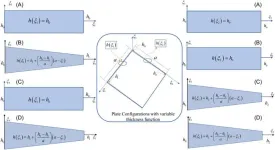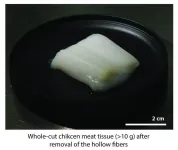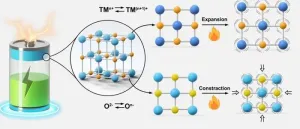(Press-News.org) Using advanced DNA sequence analysis, a research team led by NYU Tandon School of Engineering's Assistant Professor Elizabeth Hénaff has discovered that tiny organisms in Brooklyn's highly contaminated Gowanus Canal have developed a comprehensive collection of pollution-fighting genes.
The findings were published in the Journal of Applied Microbiology on April 15, 2025.
The team identified 455 species of microorganisms wielding 64 different biochemical pathways to degrade pollutants and 1,171 genes to process heavy metals. This suggests the potential of a cheaper, more sustainable, and less disruptive method for cleaning contaminated waterways than the current oft-used dredging operations.
The researchers also discovered 2,300 novel genetic sequences that could enable microbes to produce potentially valuable biochemical compounds for medicine, industry, or environmental applications.
"We found what amounts to nature's own toxic cleanup manual, but with a crucial warning," said Hénaff, who sits in NYU Tandon's Technology, Culture and Society Department and is a member of Tandon's Center for Urban Science + Progress. "These microbes have stories to tell that go beyond scientific data."
To communicate these stories effectively, Hénaff and colleagues created CHANNEL, an immersive installation at BioBAT Art Space in Brooklyn, New York featuring sculpture, prints, sound, and projections alongside over 300 gallons of native Gowanus sediment and water that has been growing over the last 9 months. The Living Interfaces Lab, Hénaff's research group, uses methods from sciences and arts to address pressing urban issues.
"While more research is needed to understand how to cooperate with these organisms effectively, the discovery of such genetic tools for pollution cleanup may offer valuable lessons for environmental restoration worldwide," Hénaff said. "I consider artistic research to be a key component in not just illustrating but also informing our scientific research." The work is on view at the exhibit’s closing event on April 18, 2025.
The team discovered genes for resistance to eight different classes of antibiotics in the canal microbes, with some coming from human gut bacteria that enter the canal during Combined Sewer Overflows – when heavy rainfall causes stormwater and untreated sewage to discharge directly into waterways. Other resistance genes were found in native aquatic species.
“The long-term coexistence of microbial communities from sewage and the natural canal environment is expected to enhance the rates of horizontal transfer of a wide array of genetic elements, and as such merits our attention for public health monitoring and surveillance as environmental ‘superbug’ reservoirs,” said Sergios-Orestis Kolokotronis, a study co-author and assistant professor of epidemiology and infectious diseases at SUNY Downstate Health Sciences University.
Despite these concerns, the study also reveals promising potential benefits. While the pollutant-degrading microbes in the canal can break down contaminants, their natural processes are too slow for practical cleanup. Understanding their genetic adaptations could help scientists develop faster methods, either by isolating specific microbes for treatment or enhancing their abilities.
Some classes of contaminants such as heavy metals are also valuable materials for industry, and bioremediation methods could be adapted to resource recovery for re-use, not just removal.
To make its discoveries, the team collected samples from 14 locations along the canal's 1.8-mile length, gathering both surface sediment and deep core samples reaching 11.5 feet below the canal floor. They found microbes capable of breaking down many historical pollutants, including petroleum products, PCBs, and industrial solvents.
The findings come as the Environmental Protection Agency continues its $1.5 billion dredging and capping operation at the canal, removing contaminated sediment and sealing remaining pollution under clean material.
The team's current study builds on prior research spanning a decade to understand the Gowanus Canal microbiome. The project began in 2014 when the current study’s co-authors Ian Quate of Fruit Studio and Matthew Seibert of the University of Virginia led the first sediment sampling, processing samples at community bio lab Genspace with study co-author Ellen Jorgensen of Biotech without Borders.
The DNA was sequenced in the lab of study co-author Christopher Mason – WorldQuant Professor of Genomics and Computational Biomedicine at Weill Cornell Medicine – as part of the Pathomap Project, now expanded to cities around the world in the metagenomics of subways and urban biomes (MetaSUB) project.
“The hardy microbial organisms of the Gowanus Canal have a unique genetic catalog of survival, which provides a roadmap for adaptation and directed evolution that we can use in polluted sites around the world,” said Mason, who serves as co-founder and Director of the MetaSUB Consortium.
Later, lead author Hénaff's team collected more samples through the BKBioReactor project while study co-author Kolokotronisgathered core samples. Bioinformatic approaches implemented by study co-authors Chandrima Bhattacharya of Weill Cornell Medicine and Rupobrata Panja of Rutgers University allowed the team to identify microbes breaking down industrial pollutants in the canal's thick sediment.
This research was supported by funding from WorldQuant Foundation, the Pershing Square Foundation, National Aeronautics and Space Administration, National Institutes of Health, National Science Foundation and NYU Tandon.
END
Microbes in Brooklyn Superfund site teach lessons on fighting industrial pollution
NYU Tandon School of Engineering-led research team discovers unprecedented genetic adaptations in Gowanus Canal organisms, revealing a potential new approach for cleaning contaminated waters and recovering valuable resources
2025-04-16
ELSE PRESS RELEASES FROM THIS DATE:
Porous and powerful: How multidirectional grading enhances piezoelectric plate performance
2025-04-16
Piezoelectric materials have long been celebrated for their ability to convert mechanical energy into electrical energy, making them indispensable in smart systems for sensing, actuation, and vibration control. However, incorporating porosity and multidirectional grading into these materials introduces a host of challenges in understanding their behavior under varying environmental conditions. These complexities are further compounded by the interaction of hygrothermal conditions with electrical and mechanical loads. As a result, there is a pressing need for more in-depth research to predict the real-world performance of these materials.
Published ...
Study finds dramatic boost in air quality from electrifying railways
2025-04-16
Switching from diesel to electric trains dramatically improved the air quality aboard the San Francisco Bay Area’s Caltrain commuter rail line, reducing riders’ exposure to the carcinogen black carbon by an average of 89%, finds a new study published today in the journal Environmental Science and Technology Letters.
The electrification of the system also significantly reduced the ambient black carbon concentrations within and around the San Francisco station, the study found.
“The transition from diesel to electric trains occurred over just a few weeks, and yet we saw the same drop in black carbon concentrations in the station as California ...
Bite-sized chunks of chicken with the texture of whole meat can be grown in the lab
2025-04-16
A bioreactor that mimics a circulatory system can deliver nutrients and oxygen to artificial tissue, enabling the production of over 10 grams of chicken muscle for cultured meat applications. These results are publishing in the Cell Press journal Trends in Biotechnology on April 16.
“Our study presents a scalable, top-down strategy for producing whole-cut cultured meat using a perfusable hollow fiber bioreactor,” says senior author Shoji Takeuchi of The University of Tokyo. “This system enables cell distribution, alignment, contractility, ...
A compact, mid-infrared pulse generator
2025-04-16
Physicists in the Harvard John A. Paulson School of Engineering and Applied Sciences (SEAS) have created a compact laser that emits extremely bright, short pulses of light in a useful but difficult-to-achieve wavelength range, packing the performance of larger photonic devices onto a single chip.
Published in Nature, the research is the first demonstration of an on-chip, picosecond, mid-infrared laser pulse generator that requires no external components to operate. The device can make what’s called an optical frequency comb, a spectrum of light consisting of equally spaced frequency lines (like a comb), used today in precision measurements. ...
Sex-based differences in binge and heavy drinking among US adults
2025-04-16
About The Study: This analysis found that past-month binge drinking among young adult females in 2021-2023 was higher than males, reversing 2017-2019 patterns, whereas males in other age groups continued to binge and heavy drink at higher rates. These findings may be due to more rapid decreases in binge drinking over time among young adult males relative to females, or to plateauing or increases in binge drinking among females. Further investigation using other nationally representative surveys is needed to elucidate these explanations.
Corresponding Author: To contact the corresponding author, Bryant Shuey, MD, MPH, email bryant.shuey@pitt.edu.
To ...
Using vibrations to see into Yellowstone's magma reservoir
2025-04-16
Beneath Yellowstone lies a magma reservoir, pulsing with molten and superheated rock and exsolved gases. Scientists have long known about the chamber’s existence, but have yet to precisely locate its uppermost boundary and characterize the contents of the chamber closest to the surface—information crucial for understanding the potential perils this volcanic feature poses.
That changed this week with new research by seismologists from the University of Utah and the University of New Mexico (UNM) who used hundreds of portable seismometers and a mechanical vibration source to render 2D seismic reflection images of the ground beneath Yellowstone’s caldera.
Using ...
From disorder to order: scientists rejuvenate aging batteries
2025-04-16
A team of scientists led by Prof. LIU Zhaoping at the Ningbo Institute of Materials Technology and Engineering (NIMTE) of the Chinese Academy of Sciences, in collaboration with researchers from the University of Chicago and other institutions, has developed zero thermal expansion (ZTE) materials. This innovation has achieved nearly 100% voltage recovery in aging lithium-ion batteries (LIBs), as detailed in a study published in Nature.
LIBs have become increasingly essential in the markets for electric vehicles and aircraft. Lithium-rich layered oxide cathode materials can deliver record capacities exceeding 300 mAh/g, thanks to revolutionary oxygen-redox (OR) ...
Metabolism shapes life
2025-04-16
New research from Barcelona and Dresden: Glycolysis — the process of converting sugar into energy — plays a key role in early development.
More than fuel: Glycolysis doesn’t just power cells — it helps steer them toward specific tissue types at critical moments in development.
Better embryo models: Stem-cell–based embryo models that rely on glycolysis form structures more similar to natural embryos.
Predict and control development in a dish: These findings improve our ability to predict and control how stem-cell-based embryo models will develop, ...
AI–enabled prediction of heart failure risk from single-lead electrocardiograms
2025-04-16
About The Study: Across multinational cohorts, a noise-adapted artificial intelligence (AI)-electrocardiogram (ECG) model estimated heart failure risk using lead I ECGs, suggesting a potential heart failure risk-stratification strategy requiring prospective study using wearable and portable ECG devices.
Corresponding Author: To contact the corresponding author, Rohan Khera, MD, MS, email rohan.khera@yale.edu.
To access the embargoed study: Visit our For The Media website at this link https://media.jamanetwork.com/
(doi:10.1001/jamacardio.2025.0492)
Editor’s ...
Immediate skin-to-skin contact in very preterm neonates and early childhood neurodevelopment
2025-04-16
About The Study: In this randomized clinical trial, 2 hours of mother-neonate skin-to-skin contact (SSC) in the delivery room did not enhance neurodevelopmental outcomes at 2 to 3 years of age. However, the SSC group demonstrated improved breastfeeding practices up to 12 months compared with standard care, suggesting that the feasible and low-cost SSC intervention should be encouraged in clinical practice.
Corresponding Author: To contact the corresponding author, Laila Kristoffersen, RN, PhD, email laila.kristoffersen@ntnu.no.
To ...
LAST 30 PRESS RELEASES:
Making lighter work of calculating fluid and heat flow
Normalizing blood sugar can halve heart attack risk
Lowering blood sugar cuts heart attack risk in people with prediabetes
Study links genetic variants to risk of blinding eye disease in premature infants
Non-opioid ‘pain sponge’ therapy halts cartilage degeneration and relieves chronic pain
AI can pick up cultural values by mimicking how kids learn
China’s ecological redlines offer fast track to 30 x 30 global conservation goal
Invisible indoor threats: emerging household contaminants and their growing risks to human health
Adding antibody treatment to chemo boosts outcomes for children with rare cancer
Germline pathogenic variants among women without a history of breast cancer
Tanning beds triple melanoma risk, potentially causing broad DNA damage
Unique bond identified as key to viral infection speed
Indoor tanning makes youthful skin much older on a genetic level
Mouse model sheds new light on the causes and potential solutions to human GI problems linked to muscular dystrophy
The Journal of Nuclear Medicine ahead-of-print tip sheet: December 12, 2025
Smarter tools for peering into the microscopic world
Applications open for funding to conduct research in the Kinsey Institute archives
Global measure underestimates the severity of food insecurity
Child survivors of critical illness are missing out on timely follow up care
Risk-based vs annual breast cancer screening / the WISDOM randomized clinical trial
University of Toronto launches Electric Vehicle Innovation Ontario to accelerate advanced EV technologies and build Canada’s innovation advantage
Early relapse predicts poor outcomes in aggressive blood cancer
American College of Lifestyle Medicine applauds two CMS models aligned with lifestyle medicine practice and reimbursement
Clinical trial finds cannabis use not a barrier to quitting nicotine vaping
Supplemental nutrition assistance program policies and food insecurity
Switching immune cells to “night mode” could limit damage after a heart attack, study suggests
URI-based Global RIghts Project report spotlights continued troubling trends in worldwide inhumane treatment
Neutrophils are less aggressive at night, explaining why nighttime heart attacks cause less damage than daytime events
Menopausal hormone therapy may not pose breast cancer risk for women with BRCA mutations
Mobile health tool may improve quality of life for adolescent and young adult breast cancer survivors
[Press-News.org] Microbes in Brooklyn Superfund site teach lessons on fighting industrial pollutionNYU Tandon School of Engineering-led research team discovers unprecedented genetic adaptations in Gowanus Canal organisms, revealing a potential new approach for cleaning contaminated waters and recovering valuable resources






